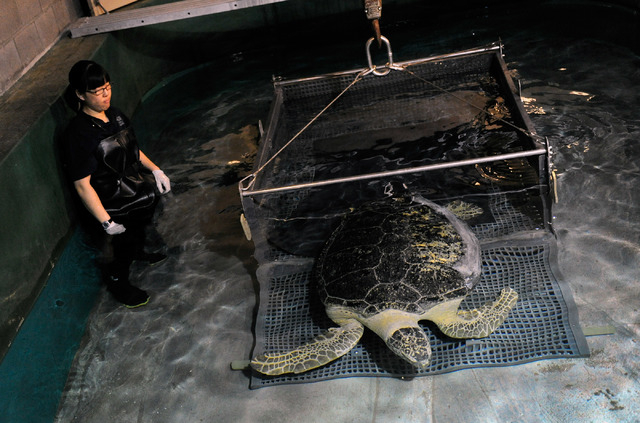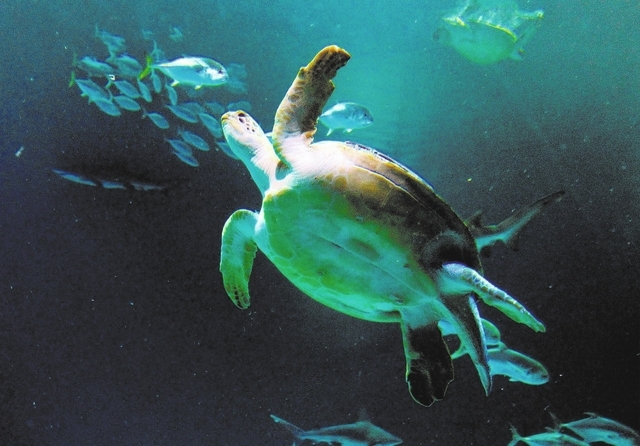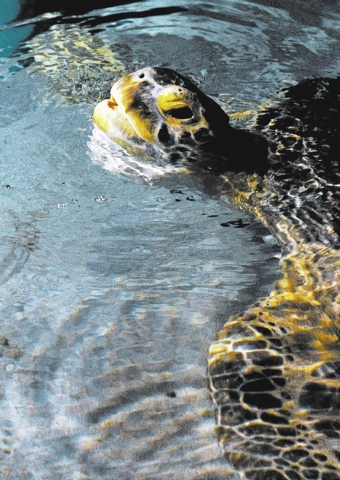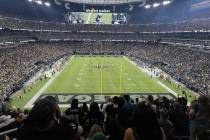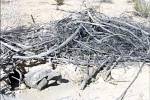Rescued sea turtle gets new life at Shark Reef
They open the gate and toss the leaves of romaine lettuce into the aquarium. The sharks ignore it, but a 320-pound sea turtle called O.D. snags the leaves from the water and eats like a hungry turtle will, and then he eats another leaf and then another one, and soon another giant turtle comes and scarfs O.D.’s lettuce, and a shark comes up to check things out and decides there’s nothing good going on up there and sinks back down, and there is O.D.
He has a decision to make as he swims around the magical lettuce garden.
There is lettuce floating all over the place, and so it must seem like heaven, and there is a turtle almost as big as O.D., chomping on the piece closest to him. O.D., being the new guy around here, and being the biggest, bulkiest guy as well, snatches the lettuce right out of the other turtle’s mouth and keeps on chomping and swimming and chomping, and there is little doubt that, if a turtle can be happy, O.D. is the happiest sea turtle in the entire Mojave Desert.
For it is here that O.D. has found salvation.
It is here, in the 1.3 million-gallon tank at the Shark Reef Aquarium inside Mandalay Bay, that O.D. the world-famous sea turtle, will spend the rest of his strange life swimming with sharks.
“Sea turtles do two things,” says Jack Jewell, the Shark Reef’s general curator. “Sleeping and eating.”
O.D. is the only animal in the aquarium with a name, Jewell says. That’s because he’s the only one with such a weird history.
RESCUED OFF COAST OF NORTH CAROLINA
O.D. started life, presumably, the same way the rest of the world’s sea turtles do. His mother laid a bunch of eggs on the same beach where she was born, buried them in the sand, and then left. The eggs hatched, the tiny little turtles crawled into the ocean, and they lived solitary lives as they grew.
And then, most probably, a boat smacked into O.D.
Sea turtles are almost black. They’re very hard to see when they’re at the ocean’s surface. They get hit by boats all the time. Despite 200 million years on this planet, they haven’t evolved a defense against boat propellers.
O.D. was found off the coast of North Carolina in 1999, obviously sick. He was brought in for treatment of a lung infection, given the name Pepper, and released back into the sea two years later.
He made his way, eventually, down to the Florida Keys.
ANIMAL RESCUERS IN FLORIDA STEP IN
There, in 2008, a charter boat named Ocean Diver happened upon this 320-pound beast of a turtle floating, crookedly.
His right side was floating higher than his left. His shell on the right was permanently poking out of the water. It was infected and yucky.
They hauled him aboard and, having no clue about his past with the name Pepper, christened him O.D., the initials of the boat they were on.
They brought him to the Turtle Hospital in Marathon, Fla., one of the few places in the United States that specializes in caring for injured sea turtles and releasing them back into the wild.
Bette Zirkelbach, the turtle hospital’s manager, says O.D.’s lung infection had led to a collapsed lung. Often, when a boat hits a big sea turtle, the shell gets damaged. The lungs in a sea turtle rest right up against the underside of that shell.
In O.D.’s case, the lung was completely useless. To compensate, the lung on his other side had a tendency to overinflate. Which is why he was floating crookedly all the time, and why he couldn’t dive properly.
They had a solution, though. They attached lead weights to O.D.’s shell on one side, which kept him level.
But it also meant he could never live in the wild again.
Turtles never stop growing. Their shells grow with them. Fine layers of the shells shed as they grow. The weights would eventually fall off. They would need replacing.
If they released O.D., he would either die or end up getting rescued again, and he’d be right back where he started.
The problem, though, was that the Turtle Hospital is not meant to be a permanent home. It’s a hospital. It has a 100,000-gallon tidal pool for the animals to recover in, and that’s it.
He needed a permanent home.
SHARING THE WATER
The Turtle Hospital’s veterinarian, Dr. Doug Mader, and Jewell, the Shark Reef’s curator, happen to know each another. Jewell said Mader has been coming to the Shark Reef annually for years to teach a seminar.
During his visit in 2012, Mader happened to mention O.D.
Bring it on, Jewell said. Shark Reef already had two huge sea turtles, both of which have been there for more than 10 years and came from other aquariums.
Why not take in a third?
A plea went out, and FedEx stepped up, providing transportation for O.D. and two people from the Turtle Hospital to Shark Reef this past July. The event received worldwide media attention.
As is typical when a new animal arrives, O.D. had to stay in Shark Reef’s 70,000-gallon holding tank for a while before he could be allowed in with the other animals.
They needed to make sure he wasn’t going to get everyone else sick. And, they wanted to examine him and make sure everything was going to be OK.
He did just fine.
Jewell says O.D. is rugged. He’s eating really well, and there don’t seem to be any problems with his behavior.
He was released into the aquarium’s main tank Thursday.
He’ll live there pretty much forever, sharing all that water with 2,000 other animals and, of course, all the lettuce a giant sea turtle could possibly want.
Contact reporter Richard Lake at rlake@reviewjournal.com or 702-383-0307.



